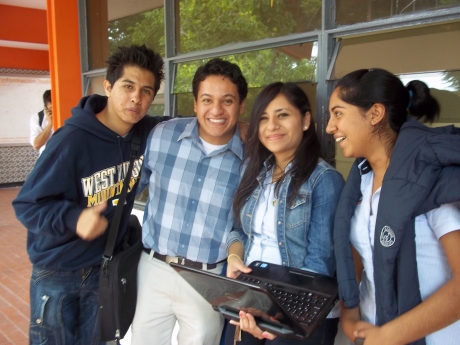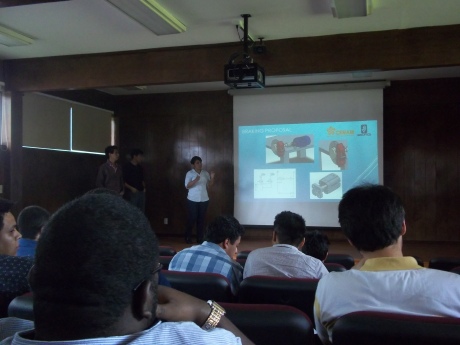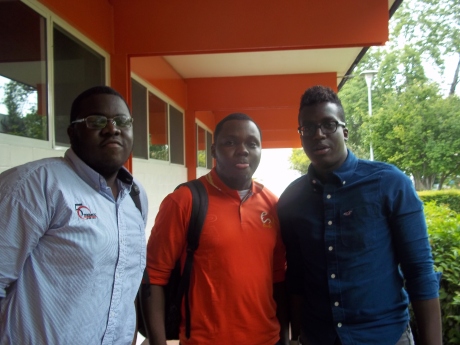One recent Friday afternoon found me in the auditorium of the Instituto Tecnologico de Queretaro where engineering students were presenting their projects. Some of them had been my students before they went to the University of West Virginia for a semester in January. I wanted to see how they did.

Student engineers from Mexico: Santiago, Gabriel, Odette, and Sara spent a semester at the University of West Virginia.
They did just fine. Gabriel was not fluent in English before he left for the US, but he said he did everything I told him. Well, let him be the first. I was still amazed at what immersion in the language could do. And “hambre.” Hunger. Gabriel is highly motivated, and that’s all anyone needs.
During his power point, he had no difficulty explaining–in English– his project concerning the refrigerator damper for the Mexican company, Mabe, while his partner, Juan, talked about making the part move like a gate. They got frustrated at one point. Then Juan said they fixed it when they came up with “a funky thing made of trash.”
Finally, I understood something they were talking about. But we’re not talking trash here. More like treasure. Carlos, an electrical engineering student and his partner, Will, a native of Ivory Coast and engineering student at WVU, were working on an innovation for a pellet machine for Brose. They figured out a way to save the company $5078 a day! A collective cheer arose from the group. That’s enough to run two Mexican households for a month.
Gonzalo, an engineering professor and mentor for the group, calmly told all the students assembled: Figure out how your projects are saving money and incorporate that into your presentations.

On Fridays, the students from Mexico and West Virginia meet to discuss the projects they are working on in the local businesses in Queretaro.
This is the 18th year of the exchange program. Victor Mucino, a Mexican professor at WVU for 29 years, started it in Guanajuato, Mexico, when he brought several engineering students to work in businesses in Queretaro. After two summers of driving for two hours, Mucino and his students were invited to move the program to Queretaro. CONCYTEQ, where I am a volunteer, has been a sponsor of the program for the past 16 years. Every January they provide scholarships to Mexican students who vie for a semester at WVU. Mucino said this year half the students in the top ten of a most difficult automation class of 96 were Mexican students.
There was little interest on the part of business here, at first. But Mucino was persistent. He has a direct gaze, an upbeat attitude and it is hard to imagine turning him down. “It was a fortunate accident,” he said. “If I hadn’t taken that crazy risk, we wouldn’t be where we are now.”
Representatives from the US embassy, the University of Nevada and other universities are going to visit the program at the end of the month to see how they might replicate Mucino’s efforts. It is the only such exchange program in Mexico. Students who have graduated are now working in the businesses and teaching. President Obama’s relatively new “100,000 Strong,” which emanates from Latin American countries toward student exchange, provides support for the group.

WVU engineering students Temi and Mofe of Nigeria and Will of Ivory Coast present their project updates in Spanish.
Before I start sounding like Mary Poppins, I must add that “tech transfer” from Mexico, and back again, has not been easy. An article in Scientific American, “Why Can’t Mexico Make Science Pay Off?,” published shortly after I arrived last September, has been boiling in my brain ever since. It talks of a country that is the “antithesis of the open-minded, meritocratic Silicon Valley way of operating” and of the “schizophrenic quality of Mexican innovation–at once dynamic and bogged down.” This has been the antithesis of qualities I’ve seen in my “classroom,” the conference room, at CONCYTEQ. They have their work cut out, and they are doing it. My students, all in engineering and the sciences, are swimming upstream with a government that is trying to help, but they are not wholly successful because of all the red tape. In addition, the notion that universities should help industry either in research or in start-ups is “new and not terribly popular” in Mexico.
Then there are those glitches on the ground, like the year a tall, blond and blue-eyed student of Mucino’s came to Queretaro and macked on a mexicana in a bar. Her boy friend hit the Americano over the head with a bottle. I observed that this could happen, and does, in Chicago. But such small things here become large, fast, and do nothing to improve Mexico’s image.
Another problem is “the plan,” and I have heard this often when referring to Mexican business. My student, Arnulfo, claims that Mexicans have a tendency to skip steps. “We don’t follow the plan. If there are six steps, Mexicans want to go to five and six before doing three and four.” This sounds more like an impatient Americano, but Arnulfo has a basis for comparison. An industrial engineer for more than 20 years, he worked for Electrolux in the US for six months. “In the US, you do the plan.”
We are left to hope for the “green shoots.” President Pena Nieto claims to be behind innovation. Mexicans are increasingly getting away from the government as the model and looking for new paths for ideas. NAFTA has opened some doors, and despite criticism, open is better than closed. Neighbors share. Where would the US be without all those ideas that have walked in our door on two legs for hundreds of years?